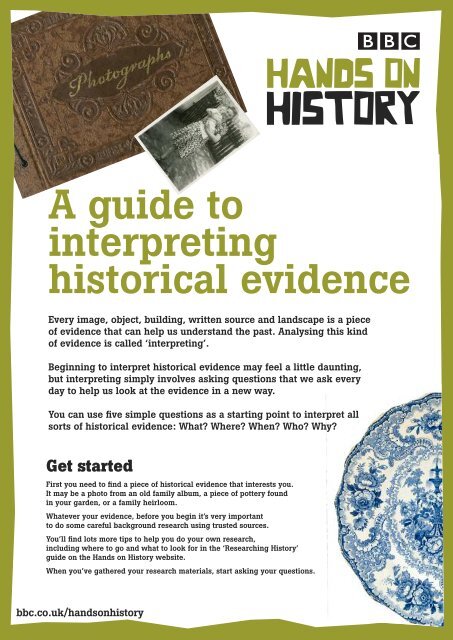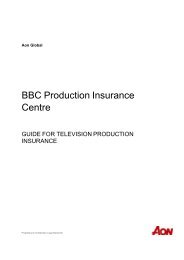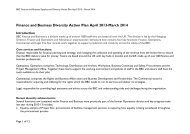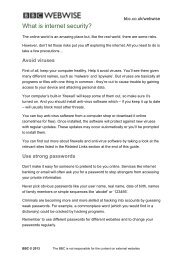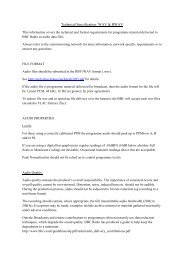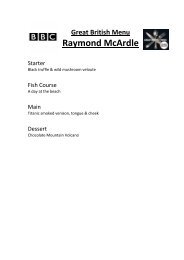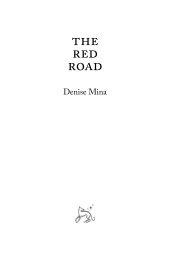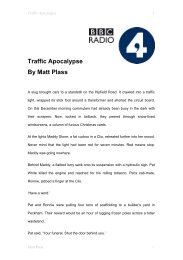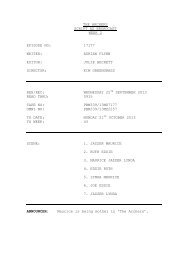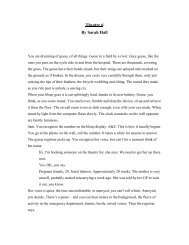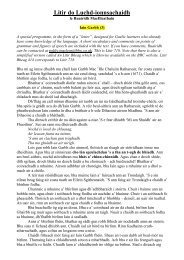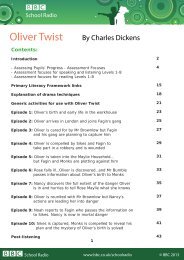A guide to interpreting historical evidence Question one - BBC
A guide to interpreting historical evidence Question one - BBC
A guide to interpreting historical evidence Question one - BBC
Create successful ePaper yourself
Turn your PDF publications into a flip-book with our unique Google optimized e-Paper software.
A <strong>guide</strong> <strong>to</strong><br />
<strong>interpreting</strong><br />
his<strong>to</strong>rical <strong>evidence</strong><br />
Every image, object, building, written source and landscape is a piece<br />
of <strong>evidence</strong> that can help us understand the past. Analysing this kind<br />
of <strong>evidence</strong> is called ‘<strong>interpreting</strong>’.<br />
Beginning <strong>to</strong> interpret his<strong>to</strong>rical <strong>evidence</strong> may feel a little daunting,<br />
but <strong>interpreting</strong> simply involves asking questions that we ask every<br />
day <strong>to</strong> help us look at the <strong>evidence</strong> in a new way.<br />
You can use five simple questions as a starting point <strong>to</strong> interpret all<br />
sorts of his<strong>to</strong>rical <strong>evidence</strong>: What? Where? When? Who? Why?<br />
Get started<br />
First you need <strong>to</strong> find a piece of his<strong>to</strong>rical <strong>evidence</strong> that interests you.<br />
It may be a pho<strong>to</strong> from an old family album, a piece of pottery found<br />
in your garden, or a family heirloom.<br />
Whatever your <strong>evidence</strong>, before you begin it’s very important<br />
<strong>to</strong> do some careful background research using trusted sources.<br />
You’ll find lots more tips <strong>to</strong> help you do your own research,<br />
including where <strong>to</strong> go and what <strong>to</strong> look for in the ‘Researching His<strong>to</strong>ry’<br />
<strong>guide</strong> on the Hands on His<strong>to</strong>ry website.<br />
When you’ve gathered your research materials, start asking your questions.<br />
bbc.co.uk/handsonhis<strong>to</strong>ry
2<br />
A <strong>guide</strong> <strong>to</strong> <strong>interpreting</strong> his<strong>to</strong>rical <strong>evidence</strong><br />
<strong>Question</strong> <strong>one</strong> – What?<br />
It may sound obvious, but when beginning <strong>to</strong> examine your <strong>evidence</strong><br />
it’s best <strong>to</strong> start from scratch and simply ask yourself – ‘What am I looking at?’<br />
This will help you do an initial visual examination of your <strong>evidence</strong> and give<br />
you a good starting point for further questioning.<br />
<strong>Question</strong> two – Where?<br />
‘Where?’ may mean something different depending on the <strong>evidence</strong> you are <strong>interpreting</strong>.<br />
For example if it is an old family pho<strong>to</strong>, you may ask ‘Where was this taken?’ or if it’s an<br />
old piece of pottery, you may ask ‘Where was this found?’<br />
Knowing where a piece of <strong>evidence</strong> came from will help us build up a picture of its his<strong>to</strong>ry.<br />
<strong>Question</strong> three – When?<br />
For his<strong>to</strong>rical interpretation ‘When?’ is a very important question <strong>to</strong> answer. You will want <strong>to</strong> know ‘When<br />
is my <strong>evidence</strong> from?’<br />
Some artefacts, including paintings or pottery, may actually have a date on them. If you are looking<br />
at something from more recent times, for example a family pho<strong>to</strong>, you may be able <strong>to</strong> find out the<br />
date by speaking <strong>to</strong> relatives or other people who were alive at the time.<br />
If you can’t work out a date from looking at your <strong>evidence</strong> you will need <strong>to</strong> do some more research<br />
using books or going online <strong>to</strong> try <strong>to</strong> work it out.<br />
Once you have a date for your <strong>evidence</strong> it’s useful <strong>to</strong> place it in<strong>to</strong> a timeline in your mind. This will<br />
help put it in the context of wider his<strong>to</strong>ry. Think about what happened before and after the date of<br />
your <strong>evidence</strong>.<br />
<strong>Question</strong> four – Who?<br />
By thinking about the ‘Who’, we can begin <strong>to</strong> see his<strong>to</strong>rical <strong>evidence</strong> not simply as objects <strong>to</strong><br />
display or research, but as things used by real people just like us.<br />
If you are looking at an image for example, this may mean ‘Who is depicted?’ Which is particularly<br />
interesting if you have a family pho<strong>to</strong>. If you have an object from the past a good ‘Who’ question<br />
would be ‘Who used this?’<br />
You can often gain a better understanding of an object by putting yourself in<strong>to</strong> the position of the<br />
‘Who’ that you identify. Imagine what it must have been like <strong>to</strong> be alive at that time and what sort<br />
of person they may have been.<br />
<strong>Question</strong> five – Why?<br />
This question will change depending on the type of <strong>evidence</strong> you are <strong>interpreting</strong> – for example<br />
it may mean ‘Why was the pho<strong>to</strong> taken?’ or ‘Why has this artefact survived?’<br />
If you are struggling for a ‘Why?’ a good question <strong>to</strong> ask is simply – ‘Why was this created?’<br />
By thinking about why a pho<strong>to</strong> was taken, why an object was made or why a letter was written, for<br />
example, we can consider the importance of the <strong>evidence</strong> <strong>to</strong> our understanding of the wider past.
3<br />
A <strong>guide</strong> <strong>to</strong> <strong>interpreting</strong> his<strong>to</strong>rical <strong>evidence</strong><br />
Approach all <strong>evidence</strong> with caution<br />
Remember <strong>to</strong> always approach your <strong>evidence</strong>, sources and even your own opinions with caution.<br />
It is very difficult for any<strong>one</strong> <strong>to</strong> be completely objective, as every<strong>one</strong> sees the world from their own<br />
point of view. When <strong>interpreting</strong> <strong>evidence</strong> or studying sources it’s important <strong>to</strong> use objective<br />
questions, keep an open mind and attempt <strong>to</strong> look at all information in a fair and balanced way.<br />
In summary:<br />
• Ask five simple questions <strong>to</strong> get you started:<br />
What? Where? When? Who? Why?<br />
• Use research from trusted sources <strong>to</strong> help you<br />
understand what you find<br />
• Approach your sources with caution<br />
Useful websites<br />
A His<strong>to</strong>ry of the World in 100 Objects<br />
Put your <strong>interpreting</strong> skills <strong>to</strong> the test and view important his<strong>to</strong>rical objects<br />
from across the world<br />
www.bbc.co.uk/ahis<strong>to</strong>ryoftheworld<br />
<strong>BBC</strong> His<strong>to</strong>ry<br />
Explore his<strong>to</strong>ry from the Egyptians <strong>to</strong> the present day, including an interactive timeline<br />
www.bbc.co.uk/his<strong>to</strong>ry<br />
<strong>BBC</strong> His<strong>to</strong>ry Trails<br />
Find information on the role of the his<strong>to</strong>rian, including more tips <strong>to</strong> help you interpret his<strong>to</strong>ry<br />
www.bbc.co.uk/his<strong>to</strong>ry/trail/htd_his<strong>to</strong>ry<br />
For useful places <strong>to</strong> go <strong>to</strong> undertake his<strong>to</strong>rical research, including libraries and archives,<br />
download the Hands on His<strong>to</strong>ry ‘Researching His<strong>to</strong>ry’ <strong>guide</strong> from the website.<br />
www.bbc.co.uk/handsonhis<strong>to</strong>ry


